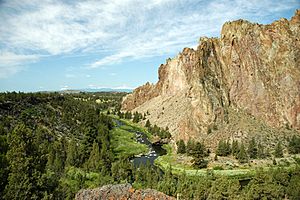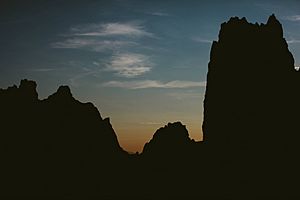Smith Rock State Park facts for kids
Quick facts for kids Smith Rock State Park |
|
|---|---|
 |
|
| Lua error in Module:Location_map at line 420: attempt to index field 'wikibase' (a nil value). | |
| Type | Public, state |
| Location | Deschutes County, Oregon |
| Nearest city | Redmond |
| Area | 641 acres (259 ha) |
| Operated by | Oregon Parks and Recreation Department |
| Open | year round |
| Status | open |
Smith Rock State Park is a cool state park in central Oregon. It's located in Oregon's High Desert area, close to the towns of Redmond and Terrebonne. This park is famous for its amazing cliffs made of rock called tuff and basalt. These cliffs are perfect for rock climbing of all kinds!
Many people think Smith Rock is where modern American sport climbing really began. It has some of the most challenging climbing routes. People come here for sport climbing, traditional climbing, multi-pitch climbing (climbing really tall routes in sections), and bouldering (climbing on smaller rocks without ropes). The park is open every day from morning until night. There's also a special area just for tent camping.
Contents
Discovering Smith Rock's Past
The name "Smith Rock" has a couple of interesting stories. One story from 1867 says it was named after John Smith. He was a sheriff and a lawmaker in Oregon. This story says he "discovered" the rock. Another story claims the rock was named after a soldier named Smith. This soldier supposedly fell to his death from the rock in 1863. His army unit was camped nearby at the time.
The State of Oregon officially got the park land between 1960 and 1975. They bought it from the City of Redmond and a couple named Harry and Diane Kem.
How Smith Rock Was Formed
The rocks at Smith Rock were made by volcanoes! About 30 million years ago, a huge caldera (a big bowl-shaped hole left after a volcano erupts and collapses) formed here. It's called the Crooked River caldera. When the ground collapsed, it created tons of rock and ash. This material filled the caldera and hardened into the rock you see today, which is called rhyolite tuff.
Later, about half a million years ago, hot lava flowed from nearby volcanoes. This lava covered the older tuff rock. Then, the Crooked River slowly cut its way through all these layers of rock. This is how it created the amazing cliffs and features we see at Smith Rock today. The highest point of Smith Rock is about 3,200-foot (980 m) above sea level. The cliffs themselves are about 600 feet (182.9 meters) tall, towering over the river.
Amazing Animals at Smith Rock
You can find lots of cool animals living in and around Smith Rock State Park.
- Mammals: You'll often see mule deer and many small mammals. Along the Crooked River, you might spot river otters and beavers.
- Birds: The park is home to many songbirds, like the canyon wren and the white-throated swift. Keep an eye out for birds of prey too, such as prairie falcons and golden eagles soaring above. In spring, geese and ducks build their nests along the river.
- Reptiles: Just be aware that rattlesnakes live in some parts of the park.
Fun Things to Do at Smith Rock
Smith Rock State Park is a fantastic place for outdoor adventures!
Hiking Adventures
The park has many miles of trails that are great for hiking. As you walk, you'll find awesome viewpoints. These spots let you look out over the Crooked River and the cool rock formations. The two most popular trails are the Summit Trail and Misery Ridge.
The park's trails also connect to other public lands nearby. It's super important to stay on the marked trails. The soil and plants on the steep hillsides are very sensitive and can be easily damaged.
Rock Climbing Challenges
Smith Rock is a world-famous place for rock climbing. It even has the first U.S. climb ever rated 5.14, which is super hard! The park is known for its tough climbing routes, attracting top climbers from all over.
In 1983, a climber named Alan Watts started using new "sport climbing" ideas here. This helped push American climbing to new levels. Between 1992 and 2009, about 500 new climbing routes were added! This made Smith Rock a global hotspot for sport climbing. Even today, climbers from around the world visit.
Winter weather can be cold, but many climbers still come because there are fewer people on the routes. Summer days can get very hot, sometimes reaching over 100°F (40°C). Some climbing routes are closed at certain times to protect birds of prey that are nesting.
Smith Rock State Park has more than 1,800 rock climbing routes! The park is divided into different climbing areas, each with its own unique features.
Monkey Face Tower
The Monkey Face area is famous for its amazing rock spire called "Monkey Face." It really looks like a monkey's face from some angles! This iconic tower is 350 feet (106.7 meters) tall and has many climbing routes. One of the most famous routes, "Just Do It" (rated 5.14c), is a big challenge for climbers to test their skills.
Right across from the "mouth" of Monkey Face is a rock called The Diving Board. It's quite close to the tower. Brave climbers can set up a "slackline" between these two spots. A slackline is a flat piece of webbing that you walk across, like a tightrope. You wear a safety line and try to balance high above the ground!
Morning Glory Wall
The Morning Glory Wall is just past Shiprock and is one of the busiest climbing areas in the park. It has routes for climbers of all skill levels. Because of where it's located, it can get very hot in the late mornings and afternoons during warmer seasons.
Picnic Lunch Wall
The Picnic Lunch Wall is often the first thing visitors see at Smith Rock State Park. It's 700 feet tall and has many climbing routes, including multi-pitch routes (where you climb in sections). This area is also where the Misery Ridge, Wolf Tree, and River Trails begin, so it gets a lot of hikers.
Red Wall
The Red Wall is found off the Misery Ridge Trail, past the Picnic Lunch Wall. The rock here has a reddish-purple color because of the iron in it, making it look different from most of the other rocks in the park. It has some classic, easier multi-pitch traditional climbs. Since it faces east, it gets direct sun in the early morning, which is nice on colder days. It's shaded in the afternoon and evening, which is great for warmer days.
Camping Under the Stars
The park has a day-use area with a visitor center, picnic tables, and restrooms. This area is open from dawn to dusk all year. There's also a special campground just for tents if you want to stay overnight. The campsites are about 600 feet (180 m) from a parking area. Near the parking, you'll find restrooms, showers, and a cooking area. You can't have open fires in the park. Many campers also stay at Skull Hollow, a nearby campground run by the Bureau of Land Management.
Trail Running Races
Smith Rock State Park is a popular spot for trail running races. These races have different distances, from 4 miles to 50 miles (6.4 to 80.5 kilometers). All the races take place on the park's challenging and hilly trails.
See also



